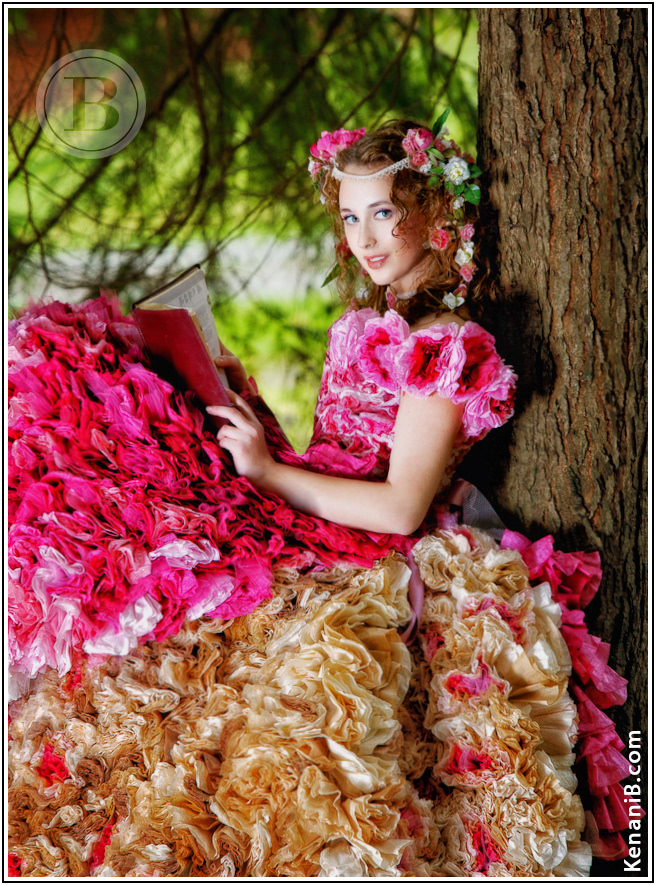“No one is an artist unless he carries his picture in his head before painting it and is sure of his method and composition.”
— Claude Monet
— Claude Monet
This gown was inspired by the great French Impressionist painter, Claude Monet, and it became the piece that sparked my obsession with art couture and ignited my love for concept photography.
As a photographer in the digital age, I have become accustomed to the immediacy of creation - images captured and viewed in an instant. The days of film, darkrooms, and hand-printing are largely gone. To truly know, plan, and painstakingly develop a photograph was once an art form in itself. Many of those intricacies have been lost with the digital camera, now even embedded in our phones, where the process often becomes one of trial and error rather than one of vision and discipline.
I wanted to step away from that culture of instant creation and change the relationship I had with my final product. In designing Monet’s Garden, I wanted a slower, more deliberate connection with my work, one that required patience, planning, and deep engagement with the process.
The construction was as much an act of devotion as design. I began by sculpting a custom dress form of my model from duct tape and Poly-fil, then sewing a simple muslin base. More than 6,000 coffee filters were hand-dyed, dried, ironed, folded, and assembled into delicate peonies. Layer by layer, I added these blooms to the muslin base, building dimension and form through color and creating the illusion of separation. The texture of the filters echoed the short, thick brushstrokes so distinctive of Impressionist art.
Monet’s Garden became my first experiment with coffee filters as a wearable medium, and through it I discovered new inspiration to keep pushing boundaries. Like the painter at their canvas, I learned the joy of watching art reveal itself slowly, with discipline, persistence, and love.
"Art takes time - Monet grew his gardens
before he painted them."
-Atticus
before he painted them."
-Atticus
6 Things I Learned About Using
Coffee Filters as an Art Medium
Coffee Filters as an Art Medium
1. Coffee filters are tougher than you think.
They held up remarkably well in the rain during the photo shoot. At first I was surprised, but then realized it makes sense, since they’re designed to withstand water. An unexpected bonus.
2. Make way more than you think you need.
Like, way more. It’s better to finish dyeing before you start folding and cutting, and better to finish folding and cutting before you begin assembling. Each stage requires its own space setup and tools. Nothing is worse than realizing at the very end you’re short on one color and having to drag everything back out to start over.
3. buy mini brass brads for bloom assembly.
Mini brass brads are a lifesaver!
They were by far the best way I found to secure multiple layers of coffee filters together quickly and securely.
They were by far the best way I found to secure multiple layers of coffee filters together quickly and securely.
4. Cut each bloom layer differently.
Every coffee filter layer has to be cut a little differently if you want fullness and texture. I stacked coffee filters, folded them, and cut them into different petal shapes. Once unfolded, I lined up the stacks and pulled one filter from each to build the peony bloom. Variation is key.
5. STRATEGIZE your drying METHOD.
Hang-drying produces the richest colors but have a very, very long drying time before you can handle them and machines drying give you most petal-like textures to the touch, but the filters don’t hold their form as well compared to other methods. Test different drying techniques to see which results work best for your vision and for the environment you’ll be shooting in. And don’t be afraid to mix it up, an iron-dried bloom is a safe bet for the base, while a delicate, richly colored bloom can be used in a more structured or protected spot.
6. Hang-drying in bulk is pure chaos.
I chose to start this creation in late fall in Seattle, which meant all the drying had to happen indoors. To dry enough filters at once, I needed a house-wide clothesline. I strung yarn everywhere—back and forth through the halls, across the kitchen, zigzagging through the living room, and even down the stairs into the studio.
At first, I loved it; it looked like a fun, festive banner. But it quickly turned into a full-on booby trap for unsuspecting family members. And heaven help us if one pin came loose, snagging a kid who wrestles with the line then panics and tares through the house with a banner whipping behind them like the Macy’s Parade.
Most importantly, hang-drying takes way too much time. And the dye doesn’t really “set” well this way for quite some time; the color tends to transfer easily onto everything, especially onto the tiny fingers, which, of course, go everywhere. I would save hang-drying for jewelry, small accessories, or delicate detailing on the gown used sparingly and made far in advance to bloom assembly.

